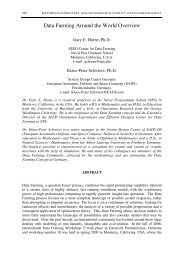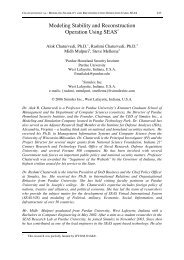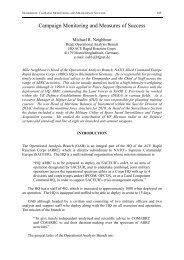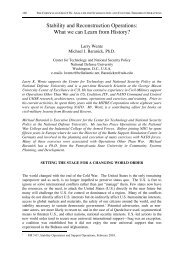The British Army's Effectiveness in the Irish ... - Cornwallis Group
The British Army's Effectiveness in the Irish ... - Cornwallis Group
The British Army's Effectiveness in the Irish ... - Cornwallis Group
You also want an ePaper? Increase the reach of your titles
YUMPU automatically turns print PDFs into web optimized ePapers that Google loves.
92 THE CORNWALLIS GROUP XIV: ANALYSIS OF SOCIETAL CONFLICT AND COUNTER-INSURGENCY<br />
assembly? <strong>The</strong> <strong>British</strong> did not <strong>in</strong>tend to conquer Ireland, so war was not <strong>the</strong> appropriate<br />
concept, but how <strong>the</strong>n to restore law and order and give Home Rule a chance with a police<br />
force that could not deal with <strong>the</strong> scale of <strong>the</strong> threat?<br />
<strong>The</strong> loss of effectiveness of <strong>the</strong> police over 1919 was dramatic and by <strong>the</strong> end of <strong>the</strong> year,<br />
two decisions had been taken. <strong>The</strong> first was to use <strong>the</strong> military to support <strong>the</strong> civil power,<br />
someth<strong>in</strong>g that could have been done <strong>in</strong> 1918 when <strong>the</strong> campaign aga<strong>in</strong>st <strong>the</strong> police started.<br />
<strong>The</strong> second was to recruit additional manpower <strong>in</strong> <strong>the</strong> form of <strong>the</strong> Black and Tans and<br />
Auxiliary Division. Figure 1 shows <strong>the</strong> growth <strong>in</strong> police numbers from July 1920 to July<br />
1921. <strong>The</strong> Dubl<strong>in</strong> Metropolitan Police, which was largely unmolested by <strong>the</strong> IRA, stayed<br />
fairly flat. However <strong>the</strong> RIC <strong>in</strong>creased by over 40%.<br />
16000<br />
14000<br />
12000<br />
10000<br />
8000<br />
6000<br />
4000<br />
2000<br />
0<br />
04/07/1920<br />
04/08/1920<br />
04/09/1920<br />
04/10/1920<br />
Figure 1: Police Numbers July 1920- July 1921.<br />
04/11/1920<br />
04/12/1920<br />
04/01/1921<br />
Unfortunately, <strong>the</strong> ability of <strong>the</strong> police to deal with crime actually fell over <strong>the</strong> same<br />
period. Figure 2 shows a range of crimes over <strong>the</strong> same period and <strong>in</strong> every case, <strong>the</strong> numbers<br />
ei<strong>the</strong>r stayed fairly constant or <strong>in</strong>creased. 12 <strong>The</strong> extra <strong>in</strong>vestment <strong>in</strong> police was clearly not<br />
turned <strong>in</strong>to improved effectiveness.<br />
<strong>The</strong> decision to <strong>in</strong>troduce <strong>the</strong> army under <strong>the</strong> Defence of <strong>the</strong> Realm Act (DORA) powers<br />
was taken <strong>in</strong> January 1920, but <strong>the</strong> lack of clarity over policy cont<strong>in</strong>ued. <strong>The</strong> army were<br />
clearly not deployed to ‘destroy <strong>the</strong> enemy with<strong>in</strong> boundaries’, but what was <strong>the</strong>ir objective<br />
and who was <strong>in</strong> command? <strong>The</strong> Dubl<strong>in</strong> Castle adm<strong>in</strong>istration controlled <strong>the</strong> police, but <strong>the</strong><br />
army still came under <strong>the</strong> War Office <strong>in</strong> London. <strong>The</strong> police gendarmerie had separate C3<br />
arrangements and did not follow military discipl<strong>in</strong>e, nor operate with<strong>in</strong> <strong>the</strong> rule of law when<br />
it began carry<strong>in</strong>g out unofficial reprisals. Confusion arose <strong>in</strong> early 1920 after <strong>the</strong> army’s<br />
powers of arrest were withdrawn <strong>in</strong> May and after large-scale releases of prisoners, on <strong>the</strong><br />
back of pressure from hunger strikes. This affected military morale and aga<strong>in</strong> provoked <strong>the</strong><br />
senior officers such as Field Marshal Sir Henry Wilson <strong>in</strong>to scath<strong>in</strong>g contempt for <strong>the</strong><br />
12 Data <strong>in</strong> Figures 1 and 2 from Townshend Campaign, 211-214.<br />
04/02/1921<br />
04/03/1921<br />
04/04/1921<br />
04/05/1921<br />
04/06/1921<br />
RIC<br />
ADRIC<br />
DMP










